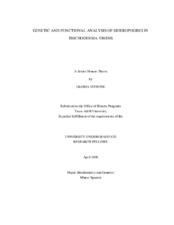| dc.description.abstract | Trichoderma virens, an avirulent plant symbiotic fungus ubiquitous in soils
worldwide, is remarkable as it induces systemic resistance in plants, enhances plant
growth, and acts as a mycoparasite of plant-pathogenic fungi. For all microorganisms,
the ability to acquire environmental iron is essential for fitness and survival. The ability
of T. virens to acquire iron from the soil determines its success as a beneficial
microorganism for plants and saprophyte of organic material. The most successful
strategy developed by microbes for iron acquisition has been the production of
siderophores, secondary metabolites that bind iron tightly and are produced in both
intracellular and extracellular forms. Extensive genomic analysis of the genome
sequence of T. virens revealed the presence of three genes, Tex10, Tex20, and Tex21 that
encode siderophore-producing enzymes known as non-ribosomal peptide synthetases
(NRPSs), but their regulation and function are largely unknown. To study the function of
these secondary metabolites in the life strategy of T. virens, two genes encoding the
NRPSs for the biosynthesis of siderophores (Tex10 and Tex20) were disrupted by fungal
transformation. While the Tex20 mutants are phenotypically very similar to wild type,
the Tex10 mutant shows some striking differences. Additionally, the Tex10 mutant
shows less ability to respond to oxidative stress. Gene expression of these NRPSencoding
genes was also analyzed in wild type and mutant strains. Siderophore
production reaches a maximum at three days in iron depleted medium, while cultures
grown in ferrated medium show a dramatic reduction in siderophore production, as well
as NRPS gene expression. Correspondingly, several NRPS-encoding gene deletion
strains reveal both lower mRNA and siderophore levels. Siderophore production at the
peak expression time was corroborated by High Performance Liquid Chromatography.
This information is essential for the enhancement of the beneficial capabilities of T.
virens for global agricultural improvement. | en |


